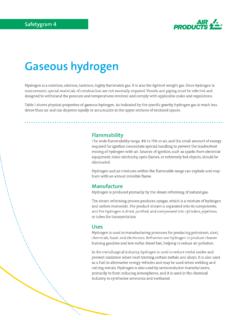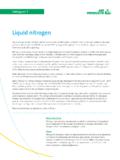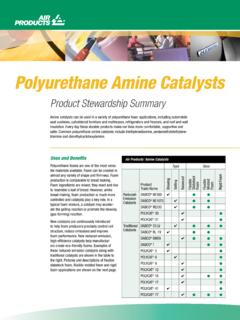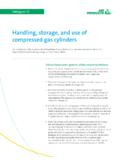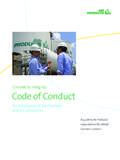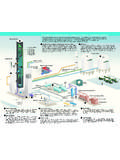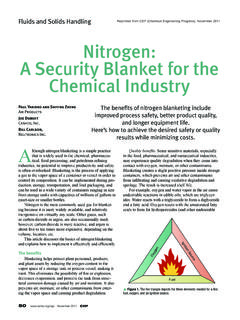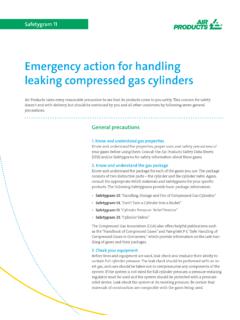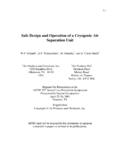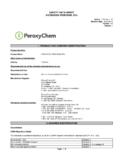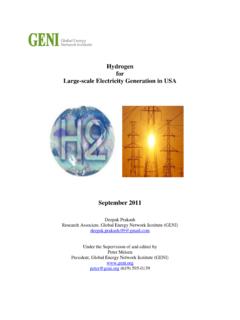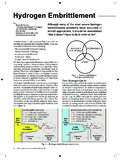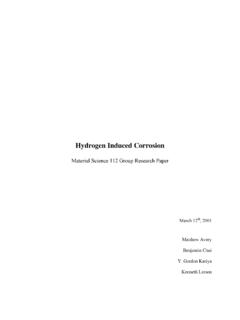Transcription of Liquid hydrogen - Air Products & Chemicals
1 Safetygram 9. Liquid hydrogen hydrogen is colorless as a Liquid . Its vapors are colorless, odorless, tasteless, and highly flammable. Liquid hydrogen is noncorrosive. Special materials of construction are not required. However, because of its extremely cold temperature, equipment must be designed and manufactured of material that is suitable for extremely low temperature operation. Vessels and piping must be selected and designed to withstand the pressure and temperatures involved and comply with applicable codes and regulations. Flammability The wide flammability range, 4% to 74% in air, and the small amount of energy required for ignition necessitate special handling to prevent the inadvertent mixing of hydrogen with air. Care should be taken to eliminate sources of igni- tion, such as sparks from electrical equipment, static electricity sparks, open flames, or any extremely hot objects.
2 hydrogen and air mixtures within the flammable range can explode and may burn with a pale blue, almost invisible flame. Manufacture hydrogen is produced by the steam reforming of natural gas, the electrolysis of water and the dissociation of ammonia. hydrogen is also a by- product of petro- leum distillation and chlorine manufacture. The primary method of hydrogen generation is steam reforming of natural gas. Other feedstocks, which are less common, can include ethane, propane, butane, and light and heavy naphtha. The steam reforming process produces syngas, which is a mixture of hydrogen and carbon monoxide. Regardless of the method of production, the product stream is separated into its components. The hydrogen is dried and purified. This gaseous hydrogen is then compressed and cooled to sufficiently low cryo- genic temperatures by the use of heat exchangers, along with reciprocating and tube expanders, to form Liquid hydrogen .
3 Table 1: Liquid hydrogen Physical and chemical Properties chemical Formula H2. Molecular Weight Boiling Point @ 1 atm F ( C). Freezing Point @ 1 atm F ( C). Critical Temperature F ( C). Uses Critical Pressure 186 psia ( atm). Liquid hydrogen is used in large Density, Liquid @ , 1 atm volumes in the space program as a ( kg/cubic meter). primary rocket fuel for combustion Density, Gas @ 68 F (20 C), 1 atm with oxygen or fluorine, and as a pro- ( kg/cubic meter). pellent for nuclear powered rockets Specific Gravity, Gas (air=1) @ 68 F (20 C), 1 atm and space vehicles. Although used Specific Gravity, Liquid @ , [water=1 @ 68 F (20 C)] more commonly in the gaseous state, Specific Volume @ 68 F (20 C), 1 atm 191 cu. hydrogen is stored and transported as Latent Heat of Vaporization 389 Btu/lb. mole a Liquid . hydrogen is a raw material Flammable Limits @ 1 atm in air (by Volume).
4 For innumerable chemical processes Flammable Limits @ 1 atm in oxygen (by Volume). ranging from the manufacturing Detonable Limits @ 1 atm in air (by Volume). of high-density polyethylene and Detonable Limits @ 1 atm in oxygen 15% 90% (by Volume). polypropylene to the hydrogenation Autoignition Temperature @ 1 atm 1,060 F (571 C). of food-grade oils. In the metallurgical Expansion Ratio, Liquid to Gas, to 68 F (20 C) 1 to 845. industry, hydrogen is used to reduce metal oxides and prevent oxidation in heat treating certain metals and alloys. hydrogen is also used by semi- Figure 1: Typical Liquid hydrogen Tanker conductor manufacturers. Health effects hydrogen gas is odorless and nontoxic but may produce suffocation by dilut- ing the concentration of oxygen in air below levels necessary to support life. Caution: The amount of hydrogen gas necessary to produce oxygen-deficient atmospheres is well within the flam- mable range, making fire and explo- sion the primary hazards associated with hydrogen and air atmospheres.
5 Containers Tanks Liquid hydrogen is normally stored Tanks are usually cylindrical in shape in on-site storage systems typically and placed in a horizontal position. consisting of a tank, vaporizer and However, some vertical cylindrical controls. Systems are selected in ac- tanks and spherical tanks are in use. cordance to usage rate, pressure and Standard tank sizes range from 1,500. regulations. gallons to 25,000 gallons. Tanks are vacuum-insulated. Pressure relief valves protect the tanks and are designed to ASME specifications. 2. Transferring Liquid Shipment hydrogen burns with a very pale blue Two persons should be present when Liquid hydrogen is transported by to almost invisible flame, therefore Liquid hydrogen is being used or trans- Liquid semitrailers with a capacity of injury may result from unknowingly ferred or when a container is moved. 12,000 to 17,000 gallons.
6 The station- walking into a hydrogen fire. The This does not apply where specially ary tanks are filled from these tank- fire and explosion hazards can be trained employees of the Liquid hydro- ers. Tankers are basically of the same controlled by appropriate design and gen supplier, who routinely handle design as the stationary tanks but in operating procedures. Preventing the Liquid hydrogen , are involved. addition must meet the requirements formation of combustible fuel-oxidant of the Department of Transportation. mixtures and removing or otherwise hydrogen is normally vaporized Figure 1 is a typical Liquid hydrogen inerting potential sources of igni- and used as a gas. Withdrawal of tanker. tion (electric spark, static electricity, Liquid from a tanker, tank, or Liquid open flames, etc.) in areas where the cylinder requires the use of a closed system, with proper safety relief de- Safety considerations hydrogen will be used is essential.
7 The hazards associated with handling Careful evacuation and purge opera- vices, which can be evacuated and/or tions should be used to prevent the Liquid hydrogen are fire, explosion, purged to eliminate the possibility of formation of flammable or explosive asphyxiation, and exposure to ex- creating a flammable atmosphere or mixtures. Adequate ventilation will tremely low temperatures. Consult explosive mixture of Liquid air and liq- help reduce the possible formation of the Air Products Safety Data Sheet uid hydrogen . Purging should be done flammable mixtures in the event of (SDS) for safety information on the with helium since Liquid hydrogen a hydrogen leak or spill and will also gases and equipment you will be can solidify other gases, such as nitro- helps eliminate the potential hazard using. The potential for forming and gen, and cause plugging and possible of asphyxiation.
8 Protective clothing igniting flammable mixtures contain- rupture of the transfer line or stor- should be worn to prevent exposure ing hydrogen may be higher than for age vessel. Liquid transfer lines must to extremely cold Liquid and cold hy- other flammable gases because: be vacuum-insulated to minimize drogen vapors, and also the potential product loss through vaporization or 1. hydrogen migrates quickly exposure to a flash fire. the formation of Liquid air on the lines through small openings. with subsequent oxygen enrichment. 3. Cold burns may occur from short All equipment must be electrically 2. The minimum ignition energy for contact with frosted lines, Liquid grounded and bonded before transfer- flammable mixtures containing air that may be dripping from cold ring Liquid . hydrogen is extremely low. lines or vent stacks, vaporizer fins, and vapor leaks.
9 Air will condense at Liquid hydrogen temperatures and can become an oxygen-enriched Liquid due to the vaporization of nitrogen. Oxygen- enriched air increases the combustion rate of flammable and combustible materials, including clothing. 3. Purging Buildings Gaseous and Liquid hydrogen systems Liquid hydrogen is normally vapor- must be purged of air, oxygen, or other ized into its gaseous state and piped oxidizers prior to admitting hydrogen into buildings for usage. For storage to the systems, and purged of hydro- of Liquid hydrogen in a building, refer gen before opening the system to the to regional codes or standards ( , atmosphere. Purging should be done National Fire Protection Association to prevent the formation of flamma- (NFPA) Storage, Use and Handling ble mixtures and can be accomplished of Compressed Gases and Cryogenic in several ways. Fluids - NFPA 55).
10 The following items pertain to a building in which gaseous Piping systems and vessels intended hydrogen is being used. for gaseous hydrogen service should be inerted by suitable purging or 1. Provide adequate ventilation, evacuation procedures. If the piping particularly in roof areas where systems are extensive or complicated, hydrogen might collect. Forced ven- successive evacuations broken first by tilation may be necessary in some an inert gas and finally with hydrogen applications. are most reliable. 2. The atmosphere in areas in which Evacuating and purging of equipment hydrogen gas may be vented and in gaseous hydrogen service should might collect should be tested with include the following considerations: a portable or continuous flam- mable gas analyzer. 1. Evacuate the equipment and break vacuum with an inert gas, such as 3. Provide an explosion venting nitrogen.
